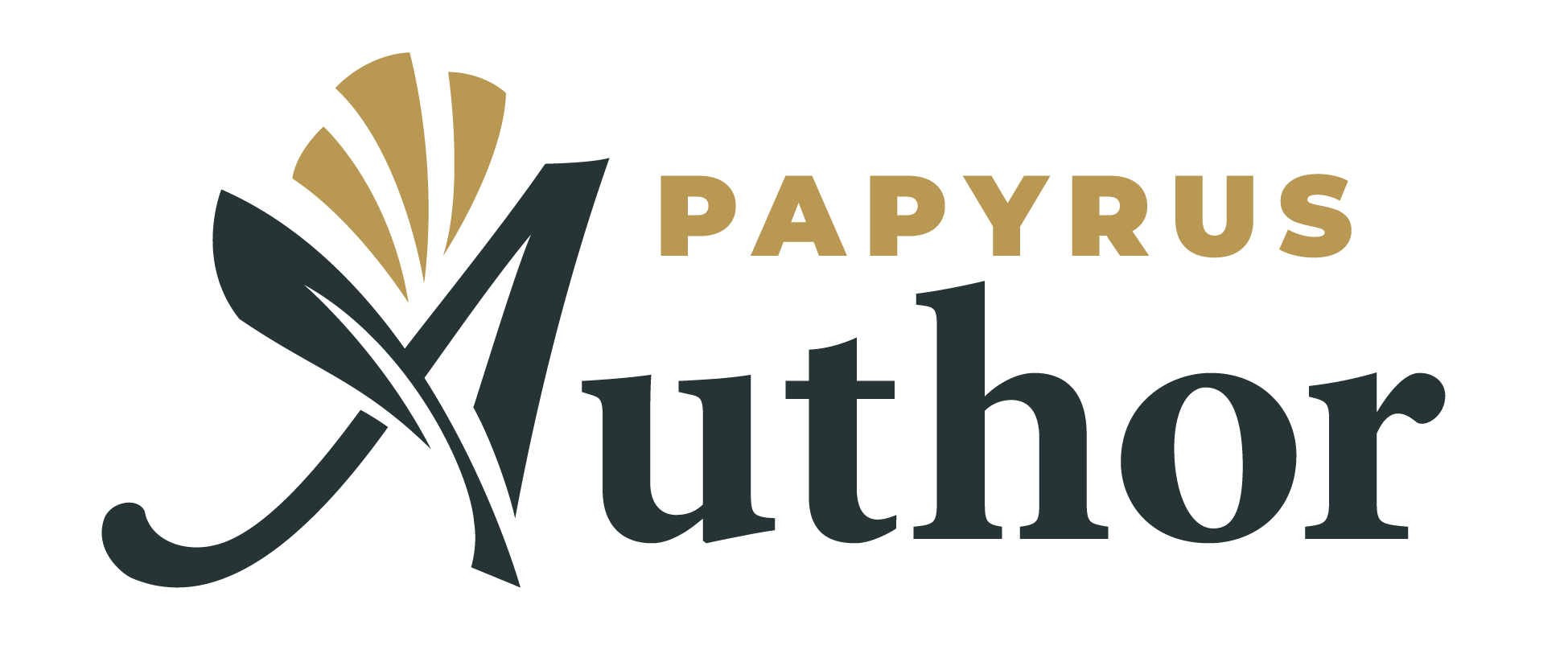Table of Contents
Papyrus Author allows you to generate PDF documents by giving you the option to save as a PDF. PDFs always look the same, regardless of which computer, tablet, etc. you use to view them.
The option to save as a PDF can be found under “Publish” in both the “File” and “Author” menus, under the “Save as…” option (icon or from the “File” menu) and also in the “Print” dialog.
The PDFs you generate are compatible with all PDF reader programs, such as Acrobat Reader from Adobe. Papyrus Author will keep the following settings when generating your PDF:
- Embedded font, with the full Unicode range (e.g. for foreign characters)
- Pictures, also with transparency and with smaller cut-outs for smaller file sizes
- Text objects with the attribute “screen readable only” will appear in a note
- Table of contents with headings
- Hyperlinks: within the document itself, on other websites or to external documents
- Author, Title, Topic, Index
- Forms with entry fields and checkboxes
PDF/PAP Hybrid–A Real PDF, But Still Editable
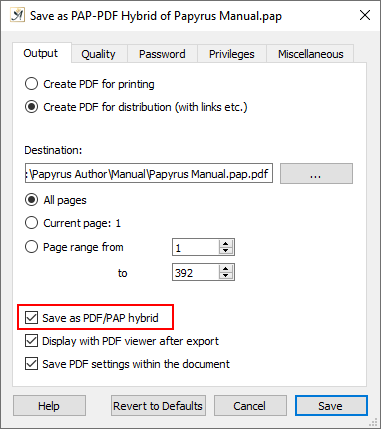
You can save your document as a PAP-PDF hybrid or a normal PDF
The PDF format normally cannot be edited. For Papyrus Author, however, we have come up with a solution for this. PDF format allows you to embed data, so Papyrus Author simply embeds a Papyrus document in the PDF, which you can later read and edit in Papyrus Author.
It is still a PDF document compatible with all reader programs, it is just a bit bigger.
This means that you will have a PDF document that you can edit and add to as you like. Searching through your hard drive for the original document you used to create the PDF, has become a thing of the past.
This hybrid format is also useful for those who work with document archiving. Up until Papyrus Author created this hybrid format, there had not been an editable format that was also universally readable.
Of course if you would simply like to generate a normal PDF without an embedded Papyrus format, Papyrus Author can do that as well.
The setting for whether you want to generate a standard PDF or a PDF/PAP hybrid can be found in the PDF Export dialog under the “Output” PDF tab.
PDF Export
The PDF export is located in the menus “File” and “Author” under “Publish,” or in the “Save as…” file selection window, by selecting “PDF” as the document type.
“Output” PDF Tab
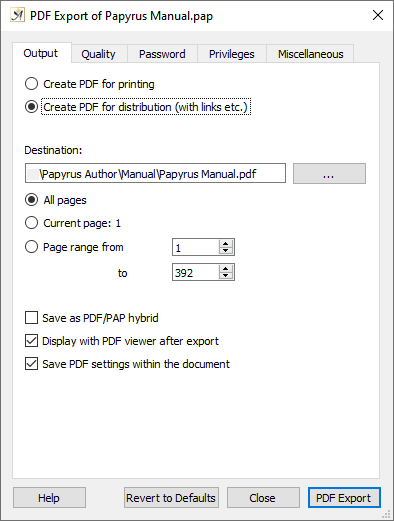
The Output settings for your PDF export
Under “Destination” you can enter the name for the PDF document you are creating.
You can either type it in directly, or use the […] button to choose it in the file selection.
You can choose to create a PDF of “ ![]() All Pages” in your current Papyrus Author document, of a “
All Pages” in your current Papyrus Author document, of a “ ![]() Page range from [x] to [y],” or only of the “
Page range from [x] to [y],” or only of the “ ![]() Current Page” (or only the area you have selected). See also the options under the “Miscellaneous” PDF tab.
Current Page” (or only the area you have selected). See also the options under the “Miscellaneous” PDF tab.
If you check the box “ ![]() Save as PDF/PAP Hybrid” you are choosing Papyrus Author’s special PDF format that allows you to create a PDF, and yet still be able to edit it later in Papyrus Author.
Save as PDF/PAP Hybrid” you are choosing Papyrus Author’s special PDF format that allows you to create a PDF, and yet still be able to edit it later in Papyrus Author.
The PDF/PAP Hybrid document you generate is a PDF document fully compatible with all PDF reader programs, such as Adobe Acrobat Reader.
If you select “ ![]() Display with PDF viewer after export,” your PDF reader program will open and display your new document once you have finished and hit the “PDF Export” button.
Display with PDF viewer after export,” your PDF reader program will open and display your new document once you have finished and hit the “PDF Export” button.
This dialog also gives you the option to “ ![]() Save PDF settings within the document.”
Save PDF settings within the document.”
Once you are finished choosing your settings, you can choose “PDF Export” and your PDF will be created.
“Quality” PDF Tab
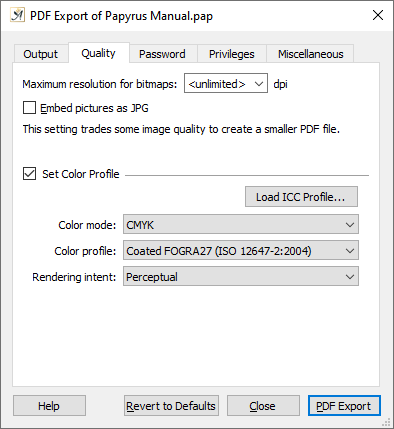
Papyrus Author can limit the PDF resolution and supports the CMYK color mode
In this tab you will find a drop-down menu to limit the resolution of your PDF.
By “Maximum resolution for bitmaps” you can choose a smaller DPI value (dots per inch) than <unlimited>. This is a good idea if your pictures (bitmaps) will not be printed in high resolution, but if you only need the pictures for a PDF available on the Internet.
Normally, Papyrus Author will keep bitmap pictures in the optimal format, e.g, TIFF, GIF, BMP, …
JPEG format (also JPG) is a compromised format that saves space, but loses some quality.
In the “Quality” tab, you can select the option “ ![]() Embed all true color pictures in JPEG format” if the PDF should stay small and is for Internet use. This is generally not recommended for printing in high resolution.
Embed all true color pictures in JPEG format” if the PDF should stay small and is for Internet use. This is generally not recommended for printing in high resolution.
For PDF, every publishing or printing house should be able to work with a normal sRGB color profile. But reality shows that several publishers or print on demand service providers can not handle proper sRGB PDF files. In this case, check “Set Color Profile” and choose the Color Profile your print on demand service provider tells you they want.
Papyrus Author will then create your PDF in perfect color separated CMYK.
“Password” PDF Tab
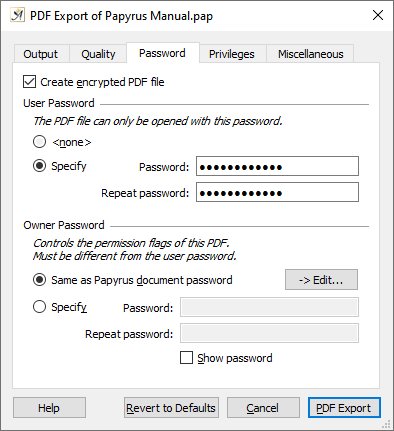
You can protect your PDF with a password
PDF documents recognize two levels of password protection. To assign password protection to your PDF, select the option “ ![]() Create encrypted PDF files.”
Create encrypted PDF files.”
If you choose to use a user password, the encrypted PDF can only be opened in a reader program, such as Acrobat, when the correct password is entered.
If you use a user password, you are also required to enter an owner password.
The owner password protects your PDF document from unwanted changes by users other than yourself.
The PDF format requires the user password and the owner password to be different.
This is especially important when you give privileges to another person. To protect the PAP part of a PDF/PAP hybrid document from unwanted changes, you should also use a Papyrus document password. To open the dialog for this option, click on the [→ Edit…] button. By selecting the option “ ![]() Same as Papyrus document password” you will tell Papyrus Author to use the same password you have set up for your document. If you want to specify another, select the “
Same as Papyrus document password” you will tell Papyrus Author to use the same password you have set up for your document. If you want to specify another, select the “ ![]() Specify” option.
Specify” option.
“Privileges” PDF Tab
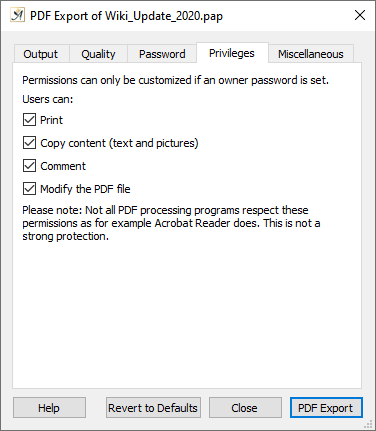
You can decide which permissions users get when working with your protected PDF
If, and only if, you have already set a PDF Owner Password, you can decide what other users are allowed to do with your PDF document.
The check boxes let you decide if another user can print the PDF, copy content, make comments or changes to the PDF.
Please note our warning at the bottom of this dialog: not all PDF editing programs will recognize and respect these restrictions.
The Papyrus Author part of a PDF/PAP hybrid, however, is safe from unwanted changes from other software, as long as you have set a Papyrus document password.
“Miscellaneous” PDF Tab
Normally, PDF formats will choose not to embed fonts that are already available in every operating system (for example Arial, Times New Roman, etc.) in order to save space.
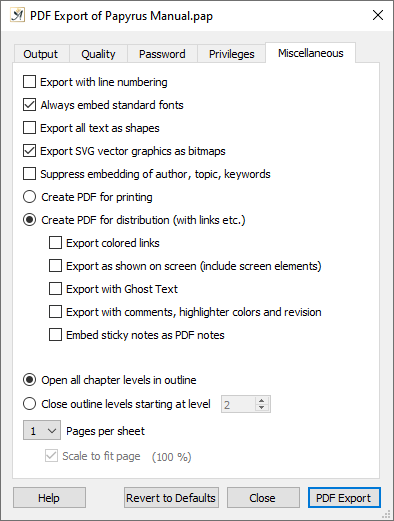
The PDF Miscellaneous settings for embedding different elements
Sometimes, though, the font you used can be falsely labeled as a “standard font,” even when it won’t be found on other computers.
There are also some printers that insist upon embedding all fonts, even the standard ones.
For cases like these you can select “ ![]() Always embed standard fonts.” This option will ensure that your PDF fulfills the purpose of a PDF, which is to look exactly how you intended, regardless of which computer is used to view it.
Always embed standard fonts.” This option will ensure that your PDF fulfills the purpose of a PDF, which is to look exactly how you intended, regardless of which computer is used to view it.
“ ![]() Export all text as shapes” will result in a direct 1:1 mapping of your text. By checking this option, though, your PDF will become a much larger file. Therefore, it is better to use the option only when you know that there are problems displaying your PDF.
Export all text as shapes” will result in a direct 1:1 mapping of your text. By checking this option, though, your PDF will become a much larger file. Therefore, it is better to use the option only when you know that there are problems displaying your PDF.
“ ![]() Export SVG vector graphics as bitmaps” might be a clever idea if you want your readers to view your text electronically, on a PC or tablet. Some PDF viewers are not able to show SVG graphics, so Papyrus Author takes care of that by converting your SVG to bitmap graphics, which can be shown on nearly every platform.
Export SVG vector graphics as bitmaps” might be a clever idea if you want your readers to view your text electronically, on a PC or tablet. Some PDF viewers are not able to show SVG graphics, so Papyrus Author takes care of that by converting your SVG to bitmap graphics, which can be shown on nearly every platform.
If you do not want your PDF readers to be able to see information such as author name, topic, and keywords, then you can select the option “ ![]() Suppress embedding of author, topic, keywords.
Suppress embedding of author, topic, keywords.
This information is taken from the “Front Matter” dialog in the “Document Properties.”
By default, Ghost Text is suppressed in printing and all kinds of export. That is the point about Ghost Text. But if you want to have it in your PDF nonetheless, check the box.
If you would like the screen elements, such as paragraph breaks, spaces, etc., to appear in your PDF, you can choose the option “ ![]() Export as shown on screen (include screen elements).
Export as shown on screen (include screen elements).
Just like in the “Print” dialog, you have the option to export with more than one page per sheet. For example, you can fit two pages horizontally on one US-Letter-sized sheet.
It is necessary to select the check box “ ![]() Scale to fit page (100%)” if your pages will be reduced to fit on the sheet, as in the example with two pages on a US-Letter-sized sheet.
Scale to fit page (100%)” if your pages will be reduced to fit on the sheet, as in the example with two pages on a US-Letter-sized sheet.
